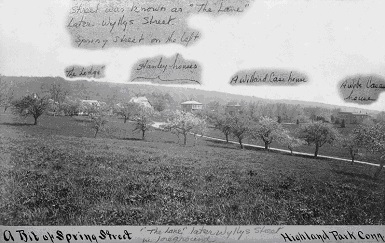
REPRINTS

Antique dealer Bob Harrison of East Middle Turnpike, Manchester, gave me a rolled-up 1923 photo of 63
employees of Case Brothers paper mill in the Highland Park section of Manchester. Bob had acquired the photo
perhaps from an estate of a former Case employee; he didn't remember the exact circumstances, but he sometimes
bought boxes of mixed items from estates, and suspects that's how this item came into his possession. I
speculate that Case Brothers gave a copy of the photo to each employee as a gift during the 1923 celebration of
Manchester's 100th anniversary of incorporation.
The 8" x 28" photo depicts the employees standing and sitting in front of the paper mills, wearing their
work clothes, as if they had just been called outside from their jobs to have their pictures taken. Photographer
Sinch Ofiara speculated that a circuit-camera was used to make this finely detailed photo; a circuit-camera is
set on a mechanical holder that is then moved across the length of the desired image, clicking photos and
advancing the film. This would account for the lack of distortion on the edges of the photo.
Photographer Dick Jenkins of Niceville, Florida, created a copy from five partial images which I scanned and
e-mailed to him. Dick sent a digitized copy via e-mail and also had his lab print three 9.5" x 34.5" copies of
the photos, and two copies are now in the possession of Case family members Susan Beach and Wells Jacobson. I
also have a copy. Aside: Dick Jenkins remembers being photographed at a school play with a circuit-camera, as
the photographer moved across the group telling each section to smile. Photographer John Ferguson looked for a
duplicated image at opposite ends of the photo � he has seen photos where a subject would run around to the other
edge of the photo before the camera got there.
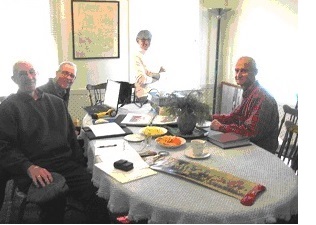
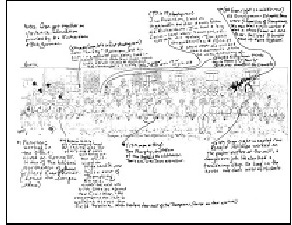 On January 5, 2012, I set up a computer projector with the photo for review and elucidation by Bob Gorman, Ed
Richardson, Susan Beach, and Wells Jacobson, pictured here, left to right, at my house at 627 Spring Street,
Manchester. Note original Case photo in bottom right of photo, and the projected image on the dining room wall
behind Wells Jacobson.
On January 5, 2012, I set up a computer projector with the photo for review and elucidation by Bob Gorman, Ed
Richardson, Susan Beach, and Wells Jacobson, pictured here, left to right, at my house at 627 Spring Street,
Manchester. Note original Case photo in bottom right of photo, and the projected image on the dining room wall
behind Wells Jacobson.
 Seated row, first man: Mr. Purinton. He worked in the office, and lived on Spring Street in one of
the houses northeast of the former A. Willard Case (now Boutot) house. The house where the Purintons lived is no
longer there. See page 4 of these notes for a Case family photo of houses along Spring St. that are no longer
there.
Seated row, first man: Mr. Purinton. He worked in the office, and lived on Spring Street in one of
the houses northeast of the former A. Willard Case (now Boutot) house. The house where the Purintons lived is no
longer there. See page 4 of these notes for a Case family photo of houses along Spring St. that are no longer
there.
 Seated row, second man: Archibald Harvey (1886-1963) came from County Down, Ireland. He had previously worked at
Hartford Rubber Works. His granddaughter, Carol Harvey Flynn, of Manchester, noted that he had an artificial
right eye. Carol remembers going up to the mill with her grandfather to get firewood. "As we went several times,
it must have been a 'perk' given to my grandfather. He was a 'fire engineer,' responsible for keeping the
boilers going at the factory."
Seated row, second man: Archibald Harvey (1886-1963) came from County Down, Ireland. He had previously worked at
Hartford Rubber Works. His granddaughter, Carol Harvey Flynn, of Manchester, noted that he had an artificial
right eye. Carol remembers going up to the mill with her grandfather to get firewood. "As we went several times,
it must have been a 'perk' given to my grandfather. He was a 'fire engineer,' responsible for keeping the
boilers going at the factory."
 Seated row, fourth man: Adam Islieb. Ed Richardson remembered that Mr. Islieb was 90 years old and
still working at the mill. He lived on Highland St., one house east of the Thompsons. "He entertained us with
stories about the Civil War." Mr. Islieb walked across the field to work.
Seated row, fourth man: Adam Islieb. Ed Richardson remembered that Mr. Islieb was 90 years old and
still working at the mill. He lived on Highland St., one house east of the Thompsons. "He entertained us with
stories about the Civil War." Mr. Islieb walked across the field to work.
 Seated row, thirteenth man: Tom Murphy, mill worker and custodian of the Highland Park clubhouse.
Tom's son was Town assessor. The Murphys lived near the Case farm on Birch Mountain Road (see more notes below).
To the right is a picture of the clubhouse.
Seated row, thirteenth man: Tom Murphy, mill worker and custodian of the Highland Park clubhouse.
Tom's son was Town assessor. The Murphys lived near the Case farm on Birch Mountain Road (see more notes below).
To the right is a picture of the clubhouse.
 Seated row, fourth man from RIGHT: Ronald Hillman. Ed Richardson provided this information: "He worked on the paper cutter at the mill, a
dangerous job. He also had a taxidermy shop. He lived in the house one door west of Nichols." His granddaughter, Karen Costantini, added in September 2014: "Grandfather Ronald Hillman lived at both 241 Highland St (1920 census) and 299 Highland St after he married Stella Sanderson. The house was a Case Bros. house, two houses from the Highland Market. The site is now the far left portion of the market's parking lot. In the early 1950s he took me to the paper mill (for a tour) and I can still see the large vats of, let's call it a brownish watery mush, that eventually became paper...The 1920 census says he was a 'roller.' He was only 17 at that time so I suspect he might have worked in other roles as time went on. In this photo he was 20."
Seated row, fourth man from RIGHT: Ronald Hillman. Ed Richardson provided this information: "He worked on the paper cutter at the mill, a
dangerous job. He also had a taxidermy shop. He lived in the house one door west of Nichols." His granddaughter, Karen Costantini, added in September 2014: "Grandfather Ronald Hillman lived at both 241 Highland St (1920 census) and 299 Highland St after he married Stella Sanderson. The house was a Case Bros. house, two houses from the Highland Market. The site is now the far left portion of the market's parking lot. In the early 1950s he took me to the paper mill (for a tour) and I can still see the large vats of, let's call it a brownish watery mush, that eventually became paper...The 1920 census says he was a 'roller.' He was only 17 at that time so I suspect he might have worked in other roles as time went on. In this photo he was 20."
 First standing row, fifth man from left: John "Lefty" Gorman, who lost his arm in a machine accident
at the paper mill. "Lefty" and his wife, Anna, lived at 325 Highland Street (built c. 1890 at the northeast
corner of Wyllys and Highland streets), the house which our guest Bob Gorman bought in 2010. Business directories
show other Case employees in this house over the years. The 1933 business directory lists John as "Driver, Case
Brothers," and the 1934 directory lists him as "Papermaker, Case Brothers."
First standing row, fifth man from left: John "Lefty" Gorman, who lost his arm in a machine accident
at the paper mill. "Lefty" and his wife, Anna, lived at 325 Highland Street (built c. 1890 at the northeast
corner of Wyllys and Highland streets), the house which our guest Bob Gorman bought in 2010. Business directories
show other Case employees in this house over the years. The 1933 business directory lists John as "Driver, Case
Brothers," and the 1934 directory lists him as "Papermaker, Case Brothers."
 First standing row, seventh man from left: Jim Robinson. He lived on Highland Street, one door west
of Ed Richardson (#203). Jim had a big farm � on the land where Somerset, etc., streets are today. Jim grew
strawberries, turnips, and other crops. Ed worked there summers when he was growing up.
First standing row, seventh man from left: Jim Robinson. He lived on Highland Street, one door west
of Ed Richardson (#203). Jim had a big farm � on the land where Somerset, etc., streets are today. Jim grew
strawberries, turnips, and other crops. Ed worked there summers when he was growing up.
 First standing row, eighth man from left: Ed thinks this is Homer (?) "Pearly" Gates, the Cases'
chauffeur � see more notes below.
First standing row, eighth man from left: Ed thinks this is Homer (?) "Pearly" Gates, the Cases'
chauffeur � see more notes below.
 First standing row, third from RIGHT in middle row: Ed Sinnamon. Ed R. notes there were three
families of Sinnamons. This man was a millworker and also a chauffeur at one time. He lived two houses east of
#203 Highland Street.
First standing row, third from RIGHT in middle row: Ed Sinnamon. Ed R. notes there were three
families of Sinnamons. This man was a millworker and also a chauffeur at one time. He lived two houses east of
#203 Highland Street.
Before the get-together, Ed Richardson, 1924-2019, jotted down names of Case Brothers employees and where
they lived. I have spoken with residents who used to live in the Case employee housing and they have said these
were good and commodious houses. Ed and his family lived at 203 Highland Street, and although his father did
work at Case Brothers at one time, the house was not "worker housing," as were many of the houses along that
street. Ed recalls that around 1930 (nine years before his father worked at Case Brothers, and he was working at
Cheney Brothers at the time), a snowplow would come from the mills and plow out all the houses � the plow was
pulled by horses. Dianne Lenti, widow of John Lenti, recalled that the horse-drawn plow came to the Lenti Farm,
too � on Gardner Street, some distance from the mills.
Ed's notes point out that he was a bit too young to identify the employees in the 1923 photo.
Transcription:
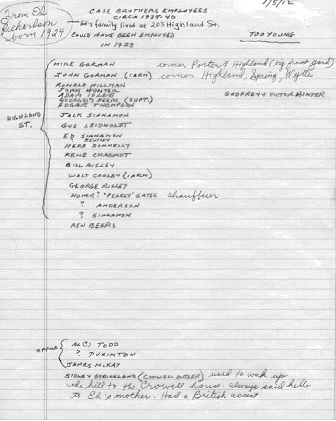
Ed also notes three employees who used to work in the office: Albert Todd; Richard Purinton; and James McKay.
Ed notes that Sidney Strickland also lived on Highland Street and that "he was the Crowell's butler. Mr.
Strickland used to walk up the hill to the Crowell house. He always said hello to my mother, Lucy Richardson."
He had a British accent. Susan Beach mentioned that Maytie Case Crowell and her husband were patrons of the arts
and set up art shows on their lawns, one featuring paintings of Melbourne Havelock Hardwick (1857-1916)
Canadian-American artist.
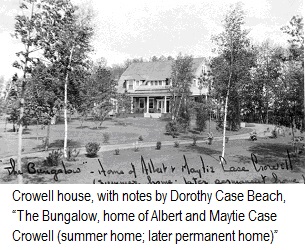 When Ed told the story of the butler, Susan Beach wasn't surprised that the Crowells would import a butler from England. They had elegant dinners and entertainment in their house on Spring Street (northeast of the A. Willard Case house and pictured in the old photo on the left).
When Ed told the story of the butler, Susan Beach wasn't surprised that the Crowells would import a butler from England. They had elegant dinners and entertainment in their house on Spring Street (northeast of the A. Willard Case house and pictured in the old photo on the left).
Ed Richardson was acquainted with Wells Case. He and Dorothy Case Beach were one year different in age. Ed
recalled playing at the mills and pelting the workers with balls of pulp, and then getting chased by the workers.
Wells Jacobson worked at the mills one summer, and recalled he had the lowest job possible � cleaning out
the pulp vat.
Bob Gorman was born in 1922. Some of his family worked at the mills, and he remembered visiting his father's
cousin, John Gorman who lived in the house where Bob now lives, northeast corner of Wyllys and Highland Streets.
Bob also remembers a Boy Scout cabin up Birch Mountain Road (near the site of the housing development for which
a great deal of blasting occurred). His grandmother Susan Gorman owned 36 acres up there, and let the Boy Scouts
use the land. There was another Boy Scout cabin on the southwest side of the Case Mountain summit � the chimney
is still there. Bob identified his father's cousin, John W. "Lefty" Gorman in the photo. Bob is in the process
(January 2012) of writing his memoirs and preparing a Gorman exhibit for the Historical Society's Old Manchester
Museum.
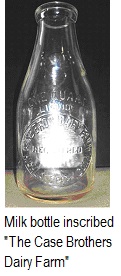
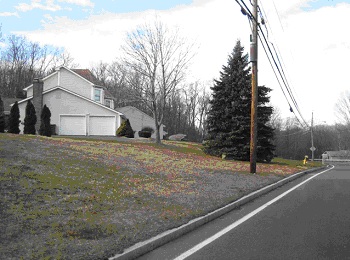 Ed Richardson pointed out that the Murphys lived below (north of) the Case farm, which was up on Birch Mountain
Road, where there are fairly new houses now. But Ed remembered exactly where the farm was. Ed also remembered
camping out with the Boy Scouts, and getting milk from the Case farm, where there were only Guernsey and Jersey
cows, who gave very rich milk. He still remembers the taste of that milk. Ed Richardson and I drove up Birch
Mountain Road on August 12, 2011, and Ed identified the location of the Case farm, on the west side of the road
near the intersection of Dennison Ridge Road, where the land is relatively flat going away from the road. There
are houses there now � see photo at right.
Ed Richardson pointed out that the Murphys lived below (north of) the Case farm, which was up on Birch Mountain
Road, where there are fairly new houses now. But Ed remembered exactly where the farm was. Ed also remembered
camping out with the Boy Scouts, and getting milk from the Case farm, where there were only Guernsey and Jersey
cows, who gave very rich milk. He still remembers the taste of that milk. Ed Richardson and I drove up Birch
Mountain Road on August 12, 2011, and Ed identified the location of the Case farm, on the west side of the road
near the intersection of Dennison Ridge Road, where the land is relatively flat going away from the road. There
are houses there now � see photo at right.
The Case family photo below, circa 1890?, shows some of the houses on Spring Street, which are no longer
there, and which are mentioned above. One of the Stanley houses was moved to Porter Street in the 1960s.
